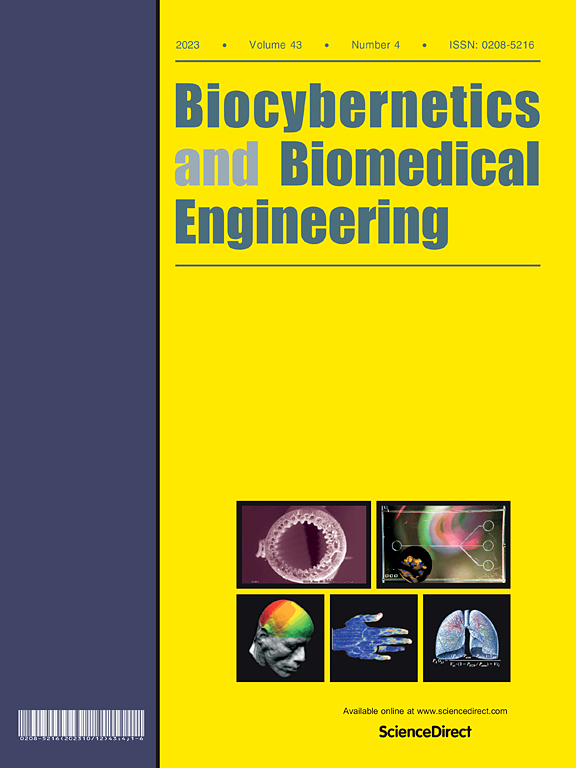基于u-net分割和卷积神经网络鱼群优化分类的肺结节图像分级分析
IF 6.6
2区 医学
Q1 ENGINEERING, BIOMEDICAL
引用次数: 0
摘要
肺恶性肿瘤是肺部细胞的异常生长,有可能侵入附近的组织并扩散到身体的其他部位。早期发现这些恶性肺肿瘤对于避免并发症和改善患者预后至关重要。但是,手工处理既耗时又繁琐。这可能导致对癌症预后的估计不准确,导致患者死亡的风险更高。现有的许多文献对恶性肿瘤进行了检测,但在确定肺癌细胞在肺区域的大小、外观和扩散情况以确定其占领程度方面存在一定的困难。因此,本研究旨在通过基于深度学习的群体智能算法来克服现有的复杂性。所建议的工作的实施涉及预处理、分割和分类三个阶段。此外,CT扫描具有比x射线更全面的视野。数据收集自LIDC-IDRI(肺图像数据库联盟-图像数据库资源倡议)的肺部ct图像,并通过使用维纳滤波器有效地去除噪声来完成预处理。此外,肺部软组织的变化在随后的阶段使用U-Net进行识别和分割,最后使用CFSO(卷积神经网络鱼群优化)进行分类,以克服误分类错误的轻微机会,因为所提出的CFSO可以带来更高效的计算过程,因为FSO算法旨在通过其元启发式特性最小化计算成本,同时最大化性能。在处理医学成像中典型的大型数据集时,这种效率尤其有益,可以在不牺牲准确性的情况下加快处理时间。因此,合并CFSO可以减少特征的数量,从而加快训练和推理时间。通过绩效评价,分析得出的IoU (Intersection over Union)值为0.7822。模型的准确率为97.80%,查全率为98.49%,查准率为96.8%,f1得分为97.32%。该研究的结果显示了该研究在临床环境中的目的,有可能减少肺癌筛查中的假阴性,最终通过早期发现和治疗提高患者的生存率。本文章由计算机程序翻译,如有差异,请以英文原文为准。
Analysis on grading of lung nodule images with segmentation using u-net and classification with Convolutional Neural Network Fish Swarm Optimization
Lung malignant tumors are abnormal growths of cells in the lungs that have the potential to invade nearby tissues and spread to other parts of the body. Early detection of these malignant lung tumors is crucial to avoid complications and improve patient outcomes. However, manual processing consumes time and is a tedious process. This might result in poor estimation on cancer-prognosis, leading the patients into a higher risk of mortality. Many existing literatures have detected the malignant tumors, yet, found certain difficulties with the identification of size, appearance and spread of cancerous-cells in lung region to determine how far it has been occupied. Hence, the present study aims to overcome the existing complications through Deep Learning based Swarm Intelligence Algorithms. Implementation of the proposed work is involved with three stages such as pre-processing, segmentation and classification. Besides, CT scan possess the capability for giving a comprehensive view than X-rays. Data are collected from LIDC-IDRI (Lung Image Database Consortium-Image Database Resource Initiative) with lung CT-images and accomplishes pre-processing by removing noise efficiently using wiener filter. Further, changes in soft tissues of lungs are identified and segmented in the subsequent phase using U-Net and finally classification is performed using CFSO (Convolutional Neural Network Fish Swarm Optimization) to overcome the slight chance of misclassification error as proposed CFSO can lead to more efficient computational processes since FSO algorithms are designed to minimize computational costs while maximizing performance through their metaheuristic nature. This efficiency is particularly beneficial when dealing with large datasets typical in medical imaging, allowing faster processing times without sacrificing accuracy. Hence, amalgamation of CFSO can reduce the number of features, thus speeding up training and inference times. Through the performance assessment, IoU (Intersection over Union) value attained through the analysis is found to be 0.7822. Further, accuracy obtained by the proposed model is 97.80%, recall is 98.49%, precision is 96.8% and F1-score is 97.32%. Findings of the study exhibits the purposefulness of the study in clinical settings by potentially reducing false negatives in lung cancer screening, ultimately improving patient survival rates through earlier detection and treatment.
求助全文
通过发布文献求助,成功后即可免费获取论文全文。
去求助
来源期刊

Biocybernetics and Biomedical Engineering
ENGINEERING, BIOMEDICAL-
CiteScore
16.50
自引率
6.20%
发文量
77
审稿时长
38 days
期刊介绍:
Biocybernetics and Biomedical Engineering is a quarterly journal, founded in 1981, devoted to publishing the results of original, innovative and creative research investigations in the field of Biocybernetics and biomedical engineering, which bridges mathematical, physical, chemical and engineering methods and technology to analyse physiological processes in living organisms as well as to develop methods, devices and systems used in biology and medicine, mainly in medical diagnosis, monitoring systems and therapy. The Journal''s mission is to advance scientific discovery into new or improved standards of care, and promotion a wide-ranging exchange between science and its application to humans.
 求助内容:
求助内容: 应助结果提醒方式:
应助结果提醒方式:


